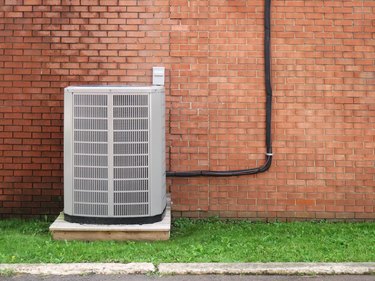
For thousands of years, humanity was the victim of the elements. From the frigid lows of a harsh winter to the sickening highs of a burning summer, people were at the whim of nature. With the aid of four-pipe HVAC technology, however, humanity has been able to create spaces where one is not only comfortable, but even able to complain about it being too cold on a sunny 104-degree day. The advent of centralized heat, ventilation and air conditioning has made life in extreme temperatures far more manageable.
How 4-Pipe HVAC Systems Work
Video of the Day
An HVAC system's piping consists of four insulated pipes: two supply lines and two return lines. One set is dedicated to chilled water, kept between 40 and 60 degrees Fahrenheit. Another set of pipes is dedicated to hot water, generally kept between 150 and 200 degrees Fahrenheit. The pipes run from a boiler or chiller to air handlers.
Video of the Day
Role of Air Handlers
Air handlers use the chilled or hot water to change the temperature of the air in the system. Air handlers in a four-pipe HVAC system can be custom designed to meet a wide variety of heating or cooling demands. They are also usually versatile in that they can be kept in mechanical rooms, on roofs or, with smaller units, in the spaces above ceilings. Air handlers feature a blower to disperse the air through the ductwork and into the home.
Role of Boilers and Chillers
The water in the system runs through two separate systems to change the temperature. Cold water is brought down in temperature through chillers, which can be located on the ground or on the roof of the building. Chillers are available in a wide variety of types to fit different budget and efficiency needs. Water is heated up using a boiler. The boiler is kept either inside or outside. As with the chillers, a number of boiler types are available for different efficiency and budget needs.
Advantages Compared to 2-Pipe HVAC
The four-pipe HVAC system has a number of advantages over a two-pipe system. Four-pipe systems have separate heating and cooling fan coil units and separate pipes for heating and cooling. This means that hot or chilled water is always available, so the system can immediately change over from heating to cooling mode. Two-pipe systems have to be manually switched over, which is not only inconvenient but time-consuming. Four-pipe systems can also cool some rooms while heating others, offering great flexibility in a building with a variety of heating and cooling needs.
Disadvantages Compared to 2-Pipe HVAC
Four-pipe HVAC systems have a number of disadvantages compared to a two-pipe system. Four-pipe systems are more expensive to install and maintain and have twice as many valves, coils, controls and pipes to maintain. They are also twice as prone to congestion because of the increased piping. Due to the lower installation cost, a two-pipe HVAC system is a more economical choice in a small building or one that doesn't have varying temperature needs.